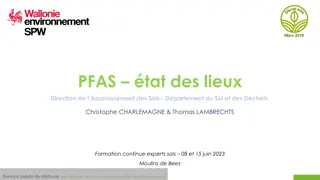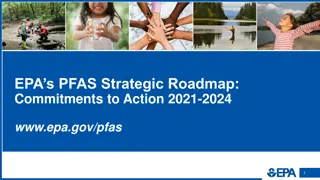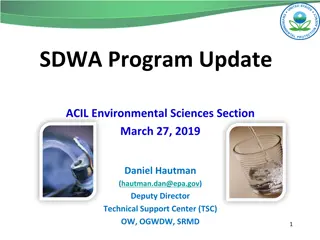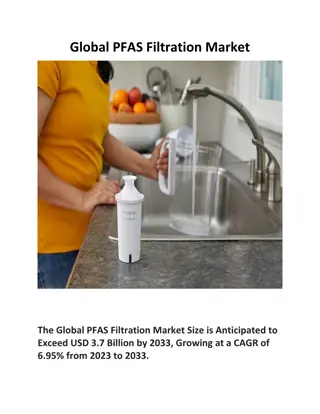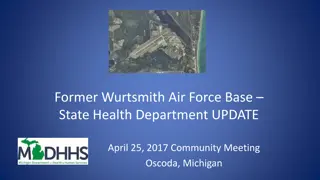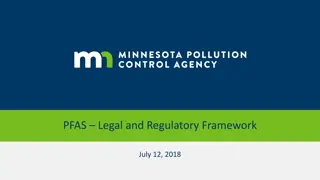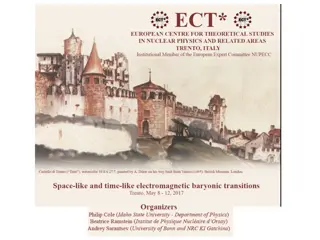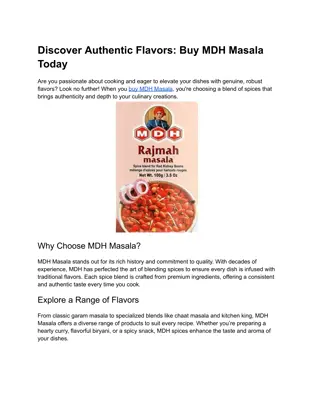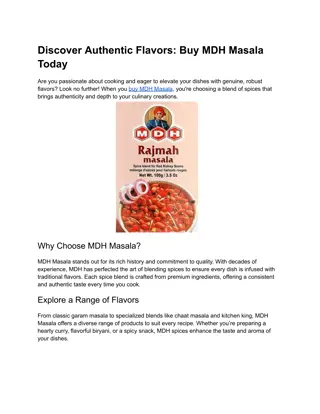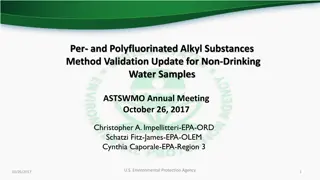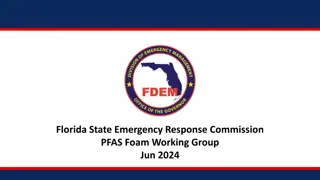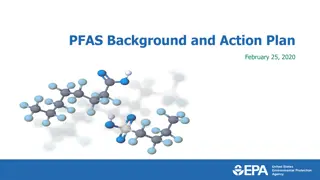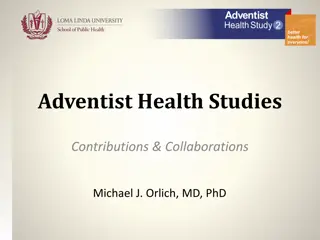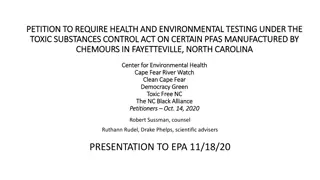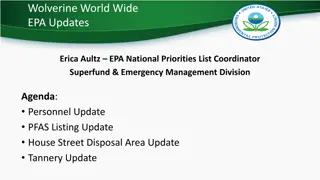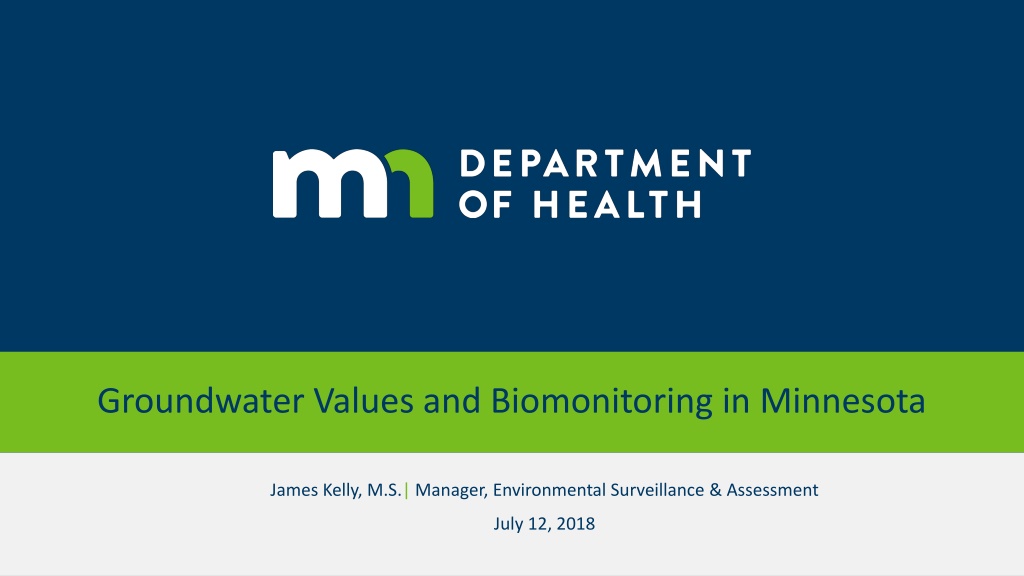
Groundwater Values and Biomonitoring in Minnesota for Health Protection
Learn about the Minnesota Department of Health's mission to protect public health through groundwater values and biomonitoring. Understand the Health Risk Limit, Health Based Value, and Risk Assessment Advice for contaminants in Minnesota's groundwater. Explore the 2017 PFAS Water Guidance and the MDH Water Guidance Standard. Discover the impact of bioaccumulation and potential health concerns related to water exposure in Minnesota.
Download Presentation

Please find below an Image/Link to download the presentation.
The content on the website is provided AS IS for your information and personal use only. It may not be sold, licensed, or shared on other websites without obtaining consent from the author. Download presentation by click this link. If you encounter any issues during the download, it is possible that the publisher has removed the file from their server.
E N D
Presentation Transcript
Groundwater Values and Biomonitoring in Minnesota James Kelly, M.S.| Manager, Environmental Surveillance & Assessment July 12, 2018
The MDH Mission - Protecting, maintaining, and improving the health of all Minnesotans.
MDH Water Guidance 1989 Groundwater Protection Act Requires MDH to protect public health by developing human health-based values for contaminants found in Minnesota s groundwater as the result of human activity. Goal is to protect this resource as a potential source of drinking water. Health Risk Limit (HRL) a concentration of a chemical, or mixture of chemicals, that is likely to pose little or no risk to human health. [Based solely on health effects & does not consider cost, technology, etc.] HRLs are promulgated in rule. Application/use is not specified in rule but is determined by individual regulatory programs Guidance values are derived between rule promulgations: Health Based Value (HBV): are rule in waiting - follows HRL derivation methodology Risk Assessment Advice (RAA) - uncertainty, use of surrogate, or different methods 7/12/2018 3
2017 PFAS Water Guidance Health Endpoints1 Water Guidance ( g/L) 2017 Previous PFAS 7 PFBA Liver and Thyroid 7 7 PFBS Developmental, Female Repro system, and Thyroid [blood system & liver no longer listed] Kidney 3 short-term & subchronic 2 chronic PFHxS 1Used in additivity (mixtures) assessments (see PFOS) (see PFOS) 0.3 PFOA More information can be found at: http://www.health.state.mn.us/divs/eh/risk/guidance/gw/table.html Developmental, Liver, Immune, and Kidney 0.035 0.3 PFOS Developmental, Liver, Immune, Liver, and Thyroid 0.027 7/12/2018 4
MDH Water Guidance Standard HRL/HBV Equation: ?? ?????? ?? ??? RSC RfD ?? ? ?? = HBG ? IR ?? ??? RfD (Reference Dose) represents a dose at which there is little or no risk of health effects (for PFOA and PFOS this dose is best represented by a serum concentration) RSC (relative source contribution) do not want total exposure to exceed RfD so you need to account for non-water sources of exposure (e.g., diet) IR (Intake Rate) how much water someone drinks 7/12/2018 5
Multiple Exposure Concerns Impact of Bioaccumulation Potential Long half-life results in exposures, even short duration, to stay in body for years beyond period of external exposure Repeated exposures lead to accumulation (build-up) within the body Water concentrations in ppt result in serum concentrations in ppb Much higher intake rates in early-life Accumulated levels can be transferred to offspring Placental transfer* (PFOA ~60 to 200%) Breastmilk transfer* (PFOA ~2.6 - 12%) * Empirical Cord:Maternal serum ratios reported in literature ** Empirical Breastmilk: Maternal serum ratio reported in literature 7/12/2018 6
Toxicokinetic Model Scenarios Formula-Fed Infant Breast-Fed Infant Maternal Serum Concentration (steady state) Clearance (t ) Maternal Serum Concentration (steady state) Clearance (t ) Placental Transfer (42% PFOS/87% PFOA) Placental Transfer (42% PFOS/87% PFOA) Neonatal Serum Concentration (birth) Neonatal Serum Concentration (birth) Breastfeeding (1.3% PFOS/5.2% PFOA) Formula Fed Infant Serum Concentration (>birth to 1 yr) Contaminated Water Contaminated Water Offspring Serum Concentration (>birth to steady state) Clearance (t ) Offspring Serum Concentration (>1 yr to steady state) Clearance (t ) Clearance (t ) (t 5.4 yrs) 7
Incorporation of Exposure via Placental & Breastmilk Transfer (Serum ~ 65 g/L) 7/12/2018 8
MDH Guidance Summary Based on protection of susceptible & highly exposed populations Protective for tap water used for drinking, cooking, showering, and other uses Cumulative additivity assessment of chemicals with similar health endpoints e.g., Liver XX g PFBA/L* + XX g PFHxS/L* + XX g PFOA/L* + XX g PFOS/L* = Health Risk Index PFBS HBV PFHxS HBG ** PFOA HBG PFOS HBG Reassessing new PFOS information (e.g., half-life) * Detected drinking water concentration **Currently using PFOS as an interim substitute Breastfeeding can be a significant exposure pathway for PFHxS, PFOS, and PFOA. However, breastfeeding is important for the short and long term health of both a mother and infant. MDH recommends that women currently breastfeeding, and pregnant women who plan to breastfeed, continue to do so. 7/12/2018 9
Biomonitoring Investigations Funded by the 2007 Minnesota Legislature Measured blood levels of 8 PFAS chemicals in two groups of East Metro residents: 149 long-term residents of Oakdale, Lake Elmo, and Cottage Grove who were exposed to PFAS in drinking water before the intervention and participated in past studies, and 156 new Oakdale residents who moved to the area after the intervention. Levels were highest in those who lived longest in the area before treatment was installed 3/18/2025 10
Biomonitoring Data Shows Interventions are Working 3/18/2025 11
PFAS levels in new Oakdale residents are similar to the U.S. population 3/18/2025 12
Thank you! James Kelly, M.S. James.kelly@state.mn.us 651-201-4910 http://www.health.state.mn.us/divs/eh/hazardous/topics/pfcs/current.html 13

